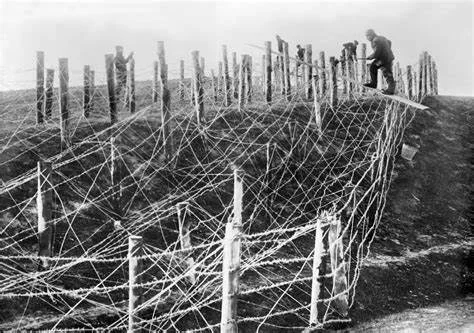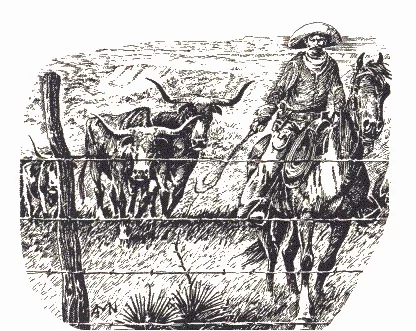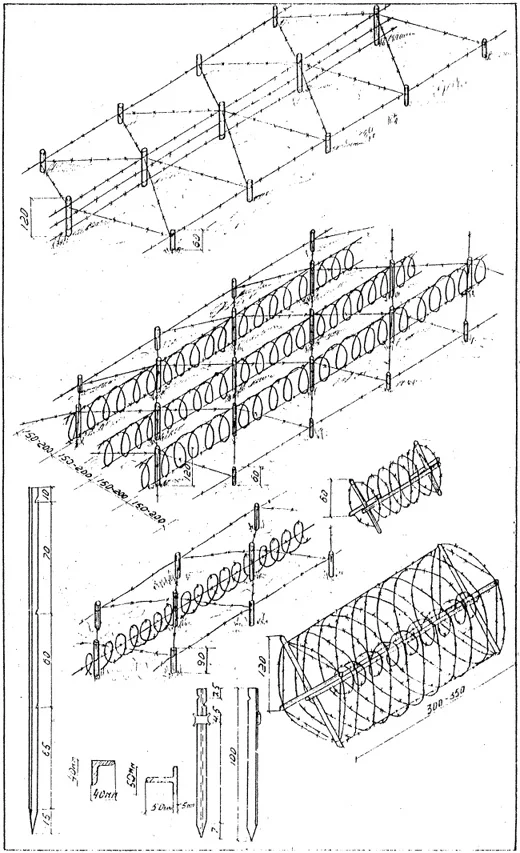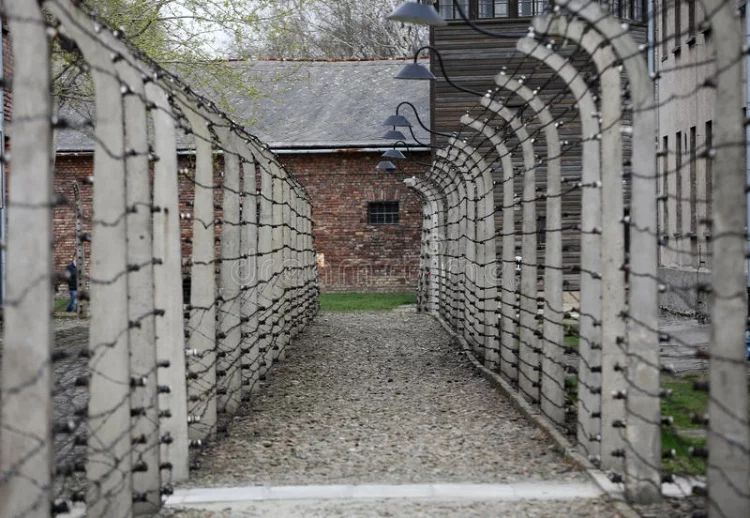All About Barbed Wire - History, Uses, Installation, Injury, and More!
by Robert Fox
Barbed wire is a form of wire fabricated so as to be covered with spikes or sometimes sharp edges arranged at regular intervals. A person or animal attempting to cross over barbed wire will be at great risk for minor, or even serious, injury.
Contents
Barbed wire is used especially in cattle fences due to its low cost, and around areas requiring increased security to prevent intrusions or escapes. Its installation is easy and does not require any special skills. Generally, these days, you buy it in rolls, at which point you need to find some points of attachment where it can be fixed with cables or staples to an upright structure such as a post.
Barbed wire has been widely used on the field of battle as well. Unfolded and deposited simply on the ground, it impedes the progress of soldiers charging forward, who can get tangled and then injured. In some cases, the wire is composed of cutting blades, or it can be used as a blockade in large coils. For certain purposes, like war, barbed wire is amassed quickly and messily, and it makes for an imposing sight.

The Twisted History of Barbed Wire

The word "barbed" comes from the english word "bramble" (from a bush or thicket), and, as a type of wire, it first appeared in United States, known as brawn wire or artificial braid wire. But the first usage of the word, "barbed" wire is the most used today still. Artificial "barbs" came not only from their resemblance to these plants but also because the first fences of this type were made from vegetation, which people would use to protect their property from both people and animals, and also add privacy.
Eventually, as wood and stone became the material of choice for farmer's fences to corral animals and deter various trespassers as the 19th century wore on, an additional more threatening material was needed. This lead to many patents and what you might call a barbed wire boom!
Patent Mania - The Cattle Are Restless!

The first serious attempt at making barbed wire was the work of Leonce Eugene Grassin-Baledans in 1860. He conceived of a fence bristling with sharp points very painful to cross. It relied on the new manufactured products of the time: wire, steel cable and other products from recent industrial processes. But the prototype he developed had its disadvantages: manufacturing time, reliability, difficulty of installation, longevity.
In April 1865, innovator Louis François Janin is on his heels and wanted to improve the prototype. For this, he was inspired by some ingenious crafting techniques. For instance, he discovered that many stable fencing installations of this type come from materials harvested in nature: branches or creepers bristling with spines. He is fascinated by the most impenetrable hedges according to his research: the hedges of burrs or other plants of the botanical genus Rubus.
The sharp prickles carried by the stems perpendicular to the latter or forming an acute angle. This has the advantage of being very painful and the acute angle increases the power of hooking the skin as well as tearing.
From this last discovery, Louis François Janin will invent a wire made up of several twisted wires. This is the current structure for economic and manufacturing reasons will most often keep only two wires twisted.
Meanwhile, in the U.S.A., in 1872, a farmer in Waterman, Illinois, developed a fence system consisting of a wire with a wooden piece with spikes to repel the Indians and prevent the cattle of the great breeders (supporters of the open range) to cross, including cowboys leading their flock to the cities of the North and East. He filed a patent in May 1873 and demonstrates this at the DeKalb county market during the summer. This innovation intrigues several inhabitants of the region, Isaac Ellwood, Joseph Glidden and Jacob Haish who decide to improve the concept. Ellwood filed a patent in February 1874.
Michael Kelly of New York in the United States had his own ideas for improvement of the barbed wire concept. Despite the model filed by the French, it is the US manufacturing process that will impose itself most thoroughly upon the various industries of the world. Through the strong demand of the farms of the American West, the advertising promotion of the new product and the industrial success is the American manufacture that will dominate from that moment the global market.
On November 24, 1874, the American Joseph Glidden of DeKalb, Illinois, filed the patent for the most widespread barbed wire and built the first machine capable of producing it in large quantities. It was an improved version that met more success than the invention of Louis Jannin in France in 1865.
Once manufactured, the tips are placed on the wire and then twisted. To keep them in place, Glidden wrapped another thread around the spikes. Ellwood bought half the concept at Glidden in July 1874 and Glidden filed his patent in November of the same year. They then founded the IL Ellwood Manufacturing Company.
When the Ellwood shop started, they fabricated a carrier wire consisting of two twisted cables. Success comes quickly, as does competition since Jacob Haish starts his own business from his patents. In 1876, Glidden sold half the shares of its patent in Washburn and Moen Manufacturing Company based in Worcester in Massachusetts. Ellwood is integrated and the trade in barbed wire continues to thrive.
It is at this point that barbed wire catches on and begins being used by people around the world for various uses. In particular, the ease with which it could be deployed made it very quickly to livestock breeders in the United States. Large areas could now be fenced, thus increasing the yield of livestock and the profitability of the land. The barriers were previously made of wood and required a lot of time to be installed and maintained.
Modern Barbed Wire and the "Range Wars"
John Warne Gates demonstrated barbed wire for Washburn Moen at the Military Plaza in San Antonio, Texas in 1876. He showed how cattle were retained by this new type of fence and invited the public to order at the Menger Hotel. Gates later moved to St. Louis in Missouri where he founded the Southern Wire Company became the largest producer of unlicensed barbed wire.
In 1881, a court decision dismissed the manufacturers and returned the monopoly to the owners of Glidden's patent. In 1892, the decision was upheld by the Supreme Court of the United States. Gates seized Washburn Moen in 1898 and transformed the company into American Steel and Wire, which was a predecessor of the United States Steel. In 1875, 270 tons of barbed wire had been produced. By 1900, more than 150,000 tons had been manufactured.
In the American south-west, barbed wire fences led to quarrels and neighborhood conflicts between the breeders (the "range war"). Some ranches allowed their livestock to graze without territorial limits, while farmers had a fenced-off area. Sometimes the owners cut the barbed wire to let the animals pass, which triggered the Fence Cutter Wars, where many people died. Finally, justice put in place a system of fines and penalties for all those who cut sons in a fence. In less than 25 years, almost all the ranches had been fenced in order to clearly delineate the possessions. Some historians that the end of the "Western Conquest" coincides with the arrival of the barbed wire.
Religious and conservative groups gave the name of Devil's Rope to the wire. Part of the public are also indignant because of injuries found on the animals as a result of the introduction of barbed wire.
Uses for Barbed Wire
Barbed wire remains one of the most common ways to establish a fence around a property. In the United States, landlords generally use barbed wire, but this is not the case for all countries. The size of the domain is also an important criterion for the use of such fences.
The wire is stretched between several solid poles and firmly planted in the ground. A system of tensioners and intermediate poles made of wood or steel make it possible to keep the cable at the right height. Boards are sometimes added between the posts to make the assembly more robust. The distance between two poles varies depending on the terrain. It can range from 3 meters on rugged terrain to nearly 50 meters on flat areas. The wooden poles are placed at maximum every 10 meters with 4 or 5 boards in between.
The wire used for agriculture falls into two categories: soft steel or high tensile steel. In all cases, the wire is galvanized to resist wear and oxidation. The high tensile steel makes the cable thinner and more resistant. It does not deform if the cattle tries to cross it. The deformation caused by the animals or the heat is compensated by its better elastic properties (it regains its initial state) unlike the soft barbed wire that remains deformed. The high tensile wire can be deployed over longer distances but its characteristics make it more difficult to install and can be dangerous if handled by inexperienced people.
In very fertile areas where the herd is denser, fences with 5 or 7 cables are common to delimit the boundaries of the domain but also to establish divisions within the property. In sheep farms, fences with 7 wires are common with 4 or 5 normal wires in the middle and barbed wires at the top and bottom. In New Zealand, the fences have to let the dogs pass because they are driving the herd. In France, it is customary for the lowest thread to pass wildlife, shepherd dogs if they are employed and hunting dogs.
Keeping Humans Out or In
Most barbed wire fences can discourage livestock but are potentially crossed by a man who can simply pass over the fence or through spreading the wires and avoiding the spikes. To limit this problem, most prisons and other high security areas install fences with cutting wire consisting of quasi-continuous blades. This type of wire inflicts wounds that are sometimes severe to the one who tries to cross it. An alternative is to place barbed wire at the top of a wire mesh. Even if the person climbs to the top of the wire mesh, his mobility is reduced and it is thus more difficult for him to pass over the barbed wire without hurting himself or hanging himself. Prisons are a good example of barbed wire used to maximum efficiency.
Barbed Wire in War Time

Barbed wire is still extensively used in modern wartime. Given the pace and power and range of weaponry, "field fortification" becomes important in war tactics. During the First World War, it was placed as an "accessory defence" in front of the trenches. As mentioned earlier, there's no substitute in war for a bunch of flesh-tearing wire strewn about the ground or positioned strategically.
Artillery fire was primarily aimed at areas of barbed wire in order to clear a passage to reach the enemy trenches. As the conflict evolved, the wire was used on reduced lengths to limit the impact of shells and facilitate its transport. During the Second World War, the wires were deployed in such a way as to slow down the infantry to make it more vulnerable to machine guns or simply to prevent the passage of soldiers, but the advent of armoured divisions with their tanks made it secondary in tactical terms. During the Afghanistan war, Afghan refugee camps in Pakistan were surrounded by barbed wire to facilitate the maintenance of these populations and to protect the Pakistanis.
Totalitarian Space Management
Barbed wire is an important part of the concentration camp realm. Already used in concentration camps in South Africa during the Boer War, it became a "central element of totalitarian space management" in the Nazi extermination camps. The death camps have double fences electrified barbed wire of 4 meters high but also "rose garden", barbed wire cage where they locked up prisoners for hours, or "road to heaven", protected by branches and barbed wire, leading to the gas chambers.
Installation a Barbed Wire Fence
The most important and time consuming part of the installation is the placement of the main posts where the wire must be attached to. Anyone who has installed a fence knows this is time consuming and generally not easy.

Rolling the barbed wire out is another consideration. You (and someone else) can use a pole to roll it out, and you are trying to avoid obstructions along the way, as well as avoid getting cut.
You will need to stretch and tighten your barbed wire, but only to a point. Over-stretching can be a problem as well. You will need a wire stretcher or come-along for this.
A support pole can be held in place by means of diagonal supports which also ensure its verticality and avoid weaknesses. Spacer cables (smooth) are connected from the top of a pole to the base of the opposite pole. These diagonal cables reinforce the structure by preventing deformation of the beams and posts.
Then, a single cable is stretched diagonally between two posts. This structure can be doubled for longer lengths. For longer distances, two cables are used and form a cross. A horizontal beam finally connects the two intermediate posts at a distance of about 250 to 300 cm, providing greater resistance to the assembly. Otherwise, the posts are 2.5 to 15 meters apart without a horizontal beam. Intervals of the order of a few meters are the most frequent.
When this first structure is constructed, the barbed wire is wrapped around an angular post and held with simple staples and then extended along the posts. The installation continues by winding it around the other angular posts and turning it on with tensioners. It is finally attached to the intermediate posts with staples that protrude temporarily in order to allow a subsequent tensioning. The installation of the series of barbed wire is done from top to bottom.
Several methods exist for attaching the wire to an angular post:
- knots: the thread is wound around the post and then knotted by hand
- splices: the two wire sections are connected together by splices on the pole
- vice: the wire is inserted into a hole in the post and then secured to the other side
- notched support: the wire is wound around the post and then held by a notched device of helical shape which retains the wire
Here is a video showing the set-up for a barbed wire fence.
In the United States, the wire used for agriculture is galvanized steel with two twisted cables and available in rolls of 402 meters. There are three categories of wire: classes I, II and III. Class I has the finest zinc layer and its lifetime is lower than other classes. It usually rusts in less than 8 to 10 years, while Class III resists between 15 to 20 years. A layer of aluminum is sometimes used in place of zinc and offers better resistance to wear.
The posts in the corners have a diameter of 15 to 20 cm, they are made of treated wood and are inserted in a buried concrete base of about 50 cm of side for 1 m of depth. The intermediate posts have a diameter of at least 10 centimeters and are embedded in a concrete base 50 cm wide and 60 cm deep. Iron poles have a diameter of at least 6.4 cm.
During the First World War, the barbed wire was fixed to the ground by means of metal poles with a large screw which was planted in the ground. Carnations were present along the post and secured the wires overnight. This system avoided the use of hammers and noisy tools that could reveal the position of the troops.
Injuries caused by barbed wire
An attempt to intrude forcefully against barbed wire, without special protection, will undoubtedly end with more or less serious injuries depending on the area of the affected body. The skin is most likely to be injured with lacerations. Deeper tissues can be affected depending on the type of yarn and its disposition. A human can limit injuries by being extremely careful when handling the wire. Limited movement, sufficiently thick clothing and gloves reduce the risk of injury.
Injuries caused by barbed wire can be found on cattle (horses, cows, etc.) but also on bats and birds. The horses panic quickly and once trapped, large pieces of flesh can be torn off, sometimes up to the bone. At best, these injuries can be treated and cured without sequelae, but sometimes the animal must be killed or died from complications (infections, septicemia, etc.). Birds and bats are not always able to distinguish spikes on the wire and suffer lacerations or cables. Less ferocious animals such as cows or sheep are less likely to have injuries as severe as those found on other animals. They retreat at the first signs of pain.
The barbed wire has sometimes been used as an instrument of torture. Used as a whip, or wrapped around a stick, it can inflict serious injuries with lacerations and severe bleeding. Humanitarian organizations are also complaining about the plight of African refugees in Melilla, Spain, where many wounds caused by the wire are to be treated. By crossing the boundary fences, refugees injure themselves deeply in the limbs.
Barbed wire is also used in the wrestling world, specifically in hardcore wrestling and hardcore match types as in federations such as Extreme Championship Wrestling and Combat Zone Wrestling.
The barbed wire also caused the death of a British car driver, Chris Bristow, at the 1960 Belgian Grand Prix, where he was decapitated by leaving the runway at full speed. The French driver Jean Larivière was also almost decapitated during his accident at the 24 Hours of Le Mans 1951 when his Ferrari left the road at the Tertre Rouge and tumbled down in a garden vegetable fenced by a barbed wire. He died shortly afterwards of his wounds.
More from my site
 |
 |
 |
 |

About Robert Fox
Rob Fox is a former hydro worker who used to teach self defence in Miami for 10 years. He's currently enjoying his retirement, playing cribbage and golf with his buddies, locksmithing and home security in his spare time. Rob is an avid reader, and has even written a few books on the subject of self defence.
Thoughts on "All About Barbed Wire - History, Uses, Installation, Injury, and More!"
 |
 |
 |
 |
Check These Out
You can Get FREE Gifts. Furthermore, Free Items here. Disable Ad Blocker to receive them all.
Once done, hit anything below
 |
 |
 |
 |